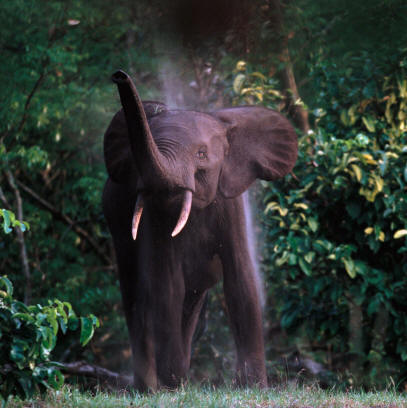Form and Function
Like all organisms, Loxodonta cyclotis must adapt to its environment. Factors such as food, water, minerals, and social and reproductive partners affect this organism's movement patterns. In response to stimuli such as these, the African forest elephant continuously adjusts its lifestyle and behaviors accordingly (Granli and Poole, 2008).
An African forest elephant herd is typically small compared to
other elephants, usually containing anywhere from two to eleven
members (Loxodonta, 2009). The herd consists of solely females and
their offsprings. This is because the males leave the herd to find
mates once they reach sexual maturity (African elephants, 2013).
The matriarch, or female leader of the clan, is the oldest member of the
herd. She decides where the herd eats, drinks, bathes, and rests
(African elephants, 2013). A herd is typically active during the
day, but if they are located in an area of high human activity and
predation, they will adapt to becoming nocturnal (Loxodonta, 2009). Rest during the day is typically spent standing up, while the few
hours of sleep the elephants receive at night is spent lying down
(Granli and Poole, 2008).
Rest during the day is typically spent standing up, while the few
hours of sleep the elephants receive at night is spent lying down
(Granli and Poole, 2008).
In the wild, elephants are rarely completely still; some part of their body is usually moving at all times, whether it is their legs, ears, eyes, trunk, or tail (Granli and Poole, 2008). An elephant such as this one is actively moving at least twenty out of the twenty-four hours in a day (Granli and Poole, 2008). They are constantly engaged with their surrounding environment, searching for food, mates, and predators. Due to their large size, Loxodonta cyclotis are rather slow-moving animals. To find meaning behind their movements, one need only observe the elephant's trunk tip, ear posture, and head angle (Granli and Poole, 2008). Dominance is shown by a raised head and trunk. The snapping of their ears and shaking of head, while making trumpeting-like noises and rumbling also displays this meaning (African elephants, 2013). On the contrary to this, submission, or the act of being under superiority, is displayed by facing their back-side to the dominant animal. Rather than raising their head, it is lowered. Likewise, they make low-pitched noises instead of higher, trumpeting ones (African elephants, 2013).
The African forest elephant's movement patterns change due to the season, its age, sex, and reproductive state (Granli and Poole, 2008). Studies have shown that during dry season, Loxodonta cyclotis population is denser near water streams and swampy areas, while during the rainy season, this species' population has been found to be spread out more throughout its typical habitat (Gunter, 1986). The elephants must adapt to water availability, changing their movement patterns to relocate near water sources. In the same way, Loxodonta cyclotis adjust their patterns according to food availability. Factors such as dust and grit in the air and soil at the place of feeding may cause the elephant to migrate to a more clear location to find food. Grass length is another environmental stimuli that affects their location (Lister, 2013).
Over the years, Loxodonta cyclotis have evolved many physical and behavioral adaptations to adjust to covering long distances to meet their lifestyle requirements. Elephants have adapted to what is referred to as "long-distance living". They have developed a pouch for water in their pharynx, or throat area, which allows them to survive long walks with no water (Granli and Poole, 2008). Thick, pillar-like legs and cushioned feet have evolved to support their increasing weight and size. This allows them to walk long distances and over various environments, especially rough surfaces (Granli and Poole, 2008). In addition to physical adaptation, mental ones have evolved as well over the years. These elephants have developed extreme parental care and defense behaviors, along with specialized traits wchich allow them to send, receive, and interpret vocalized signals within their herds (Granli and Poole).